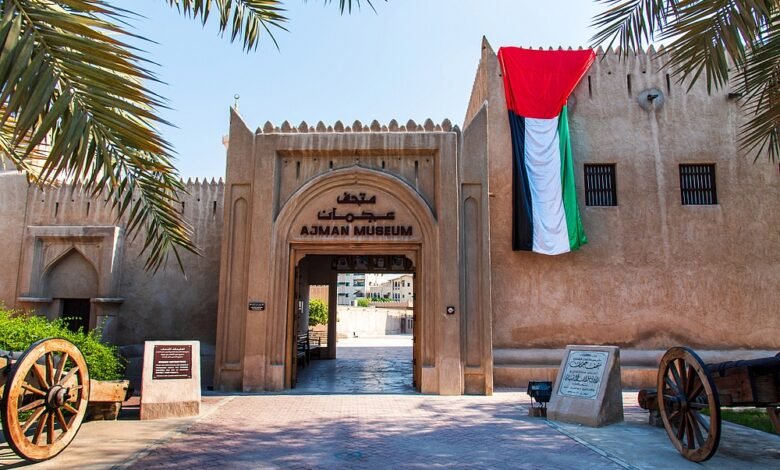
Ajman Museum: Hidden Secrets of a 3,000-Year-Old Fortress
The Ajman Museum fascinates visitors with its exceptional display of Emirati history and cultural heritage that spans 3,000 years. This historical treasure sits in an 18th-century fort that was once the residence of Ajman’s rulers and served as the Ruler’s office until 1970. Traditional Emirati architecture shines through the building’s distinctive wind towers, wooden doors, and coral stone walls.
The museum has several sections that give visitors a rich glimpse into the emirate’s past. Each themed room tells a unique story about traditional medicine, weapons, farming, and Ajman’s first radio station. The archeological section is particularly special. It contains artifacts from the Al Muwaihat site, including pottery and funeral jewelry that dates back to 3000 BC. Visitors who want to make the most of their cultural experience in one of UAE’s seven Emirates should check the museum’s timings and ticket prices before their visit.
The Origins of Ajman Fort Museum
Image Source: Glimpses of UAE
Ajman Fort, built around 1775, stands proudly as one of the UAE’s oldest working buildings. For almost 200 years, this fortress protected the city and served as the official home of Ajman’s rulers.
The fort’s story took a dramatic turn when British warships completely destroyed it in 1820. Sheik Humaid bin Rashid Al Nuaimi rebuilt it over the next decade. The fort became home to eleven different sheikhs throughout its history. Sheik Rashid bin Humaid was the first ruler, and Sheik Rashid bin Humaid bin Abdul Aziz Al Nuaimi, who ruled from 1928 to 1981, was the last.
The builders used coral stone from the sea, burnt lime, and local woods to create this masterpiece. The fort’s impressive structure spans 2,500 square meters and features two round watchtowers, one square tower, and several rooms. Two distinctive wind towers (barjeels) crown the fort, and one of them is believed to be the UAE’s oldest working wind tower.
The fort’s role changed when it became Ajman Police headquarters from 1970 to 1978. His Highness Sheik Humaid bin Rashid Al Nuaimi recognized the fort’s historical value and turned it into a museum in 1981. After three years of careful restoration work, Ajman Museum opened its doors to visitors in 1991.
Inside the Museum: Exhibits That Tell Ajman’s Story
Image Source: Bayut
Ajman Museum holds a wealth of treasures that give visitors a captivating look into the emirate’s rich cultural heritage. The museum features carefully curated exhibits in rooms of different themes that showcase traditional Emirati life in all its aspects.
The traditional medicine display captures visitors’ attention with ancient healing methods and remedies used before modern healthcare arrived. The weapons collection shows how defensive tools changed through Ajman’s history, from simple daggers to advanced military equipment.
Visitors can explore the agricultural heritage area to learn about farming techniques that helped sustain generations of coastal communities. History buffs will love the reconstructed first radio station of Ajman that includes original broadcasting equipment which connected the emirate to the rest of the world.
The archeological section stands out with its remarkable finds from the Al Muwaihat site. These valuable artifacts include pottery and funeral jewelry from 3000 BC that connect us directly to the region’s earliest inhabitants.
A walk through the ethnographic gallery reveals authentic Emirati household settings with genuine furniture and everyday tools. This section shows how families lived, cooked and spent time together in the past. Arabic and English descriptions next to each exhibit explain their importance clearly, making the museum a great learning experience for people from all walks of life.
Planning Your Visit to Ajman Museum
A visit to the historic Ajman Museum needs minimal planning but offers rich cultural rewards. The museum opens its doors from Saturday through Thursday between 8:00 am and 8:00 pm. Friday hours are 2:30 pm to 8:00 pm. The affordable entry fees make this cultural landmark available to everyone. Adults pay just AED 5, families (whatever their size) AED 15, and school students only AED 1.
The museum’s location in Al Bustan area puts it right in central Ajman. You’ll find it next to the Gold and Traditional Souqs, with the beautiful Corniche just a short walk away. Dubai visitors can reach the museum in about an hour by taking Sheik Mohammed Bin Zayed Road. The E400 and E303 busses from Dubai and Sharjah serve as public transport options.
Most people spend two to three hours exploring the exhibits. You can take photos in most areas, but avoid using flash in some sections. Weekday afternoons provide a peaceful atmosphere for exploration, especially when you have a quieter experience in mind. A museum visit pairs well with a relaxing Corniche walk or some shopping at the nearby Gold Souq to round out your Ajman experience.
Ajman Museum opens a fascinating window into the emirate’s rich past and gives visitors an authentic glimpse of Emirati heritage that spans three millennia. The 18th-century fortress’s coral stone walls, distinctive wind towers, and preserved artifacts tell countless stories. This historic structure has changed from a ruler’s residence to police headquarters, and now serves as a cultural treasure that teaches new generations about Ajman’s development.
The museum’s diverse exhibits give a complete picture of traditional Emirati life. Visitors can learn about ancient medical practices and agricultural techniques that kept communities thriving for centuries. The archeological collection showcases 5,000-year-old artifacts from Al Muwaihat that create a direct link to the region’s earliest inhabitants.
The museum’s central location near the Gold Souq and Corniche makes it easy to visit. Reasonable entry fees help families, students, and history buffs experience this historical gem without breaking the bank.
Guests step back in time as they admire the UAE’s oldest working wind tower and traditional fishing tools inside these historic walls. Ajman Museum is more than just a home for artifacts – it stands as proof of this coastal emirate’s enduring spirit and rich cultural heritage. People who want to see beyond the UAE’s modern skylines will find this hidden fortress a rewarding and essential stop.




